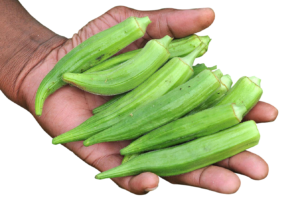Okra!

By Chef Nancy Berkoff, EdD, RD
Some people shudder when you mention okra. They have visions of a vegetable that leaves slimy tracks across the plate. They’re not suffering from okra-phobia. They are just victims of improper okra preparation.
Okra has been around for a long time and been loved. It can trace its roots to Ethiopia and Sudan. As early as the 13th century it was said to be growing along the Nile River. From Africa, okra readily found its way to the Middle East where it is still served in a traditional stew of okra, tomatoes, onions, garlic, lemon juice, and olive oil. In India you can enjoy okra in sabzi bhindi, okra fried in oil with cumin and onions and seasoned with spices. In the Caribbean, you can find many versions of callaloo, a savory okra stew.
Okra’s characteristic sticky stuff comes from a natural polysaccharide and acid combination. When okra is cut, it releases these chemical compounds and makes an ideal, natural thickener. Okra is a great food to thicken sauces or soups without using fat.
Let’s talk health. If you’re looking to add more fiber in your diet, look to the small-but-mighty okra. A 1/2-cup serving of steamed okra has 2 grams of fiber. Okra has lots of Vitamin A, vitamin B6, vitamin C, Vitamin K, and folate, and a decent amount of potassium and calcium. Who needs the multivitamins? Just add some okra to your soup!
If purchasing fresh okra, select smaller and plumper. Long, slender okra can be a bit tough and/or dry. Fresh okra should be prepared as closed to cooking as possible. Give a quick rinse, slice off the caps and then cook, either whole or sliced. If using frozen okra, do not thaw prior to cooking.
Okra can be steamed, braised, stir-fried, sautéed, or fried and served on its own or added to soups and stews. The key for successful okra is to either “cook it quick” for a firm, non-gooey texture or to let it stew, releasing its nuanced flavor and thickening ability. Frozen, sliced okra can be easily added into rice, pasta, barley, couscous, or quinoa for extra flavor, color, and crunch. Leftover cold okra can be tossed into salads. There are no excuses not to add a little okra to your weekly routine! Enjoy this recipe:
Okra Creole Stew
(Serves 6-8)
2 cups canned, drained chopped tomatoes
2 cups fresh okra, washed, stem ends trimmed off or frozen okra (thawed before cooking)
½ cup diced onion
½ cup diced red bell pepper
¼ cup diced green bell pepper
1 clove garlic, minced
¼ teaspoon dried cumin
¼ teaspoon dried thyme
½ teaspoon dried oregano
½ teaspoon dried marjoram
1 teaspoon ground black pepper
2 teaspoons hot sauce, or to taste
2 cups vegetable stock or water
2 Tablespoons cornstarch
2 Tablespoons water
Combine all ingredients, except cornstarch and water, in a deep pot. Cook over high heat, stirring, for five minutes, or until okra is just tender. Cook for one additional minute. Briskly stir cornstarch and water together to make a slurry, add to pot, and continue to cook and stir until the stew is bubbly and thick.
Serve over fluffy steamed rice, corn bread, or baked potatoes
